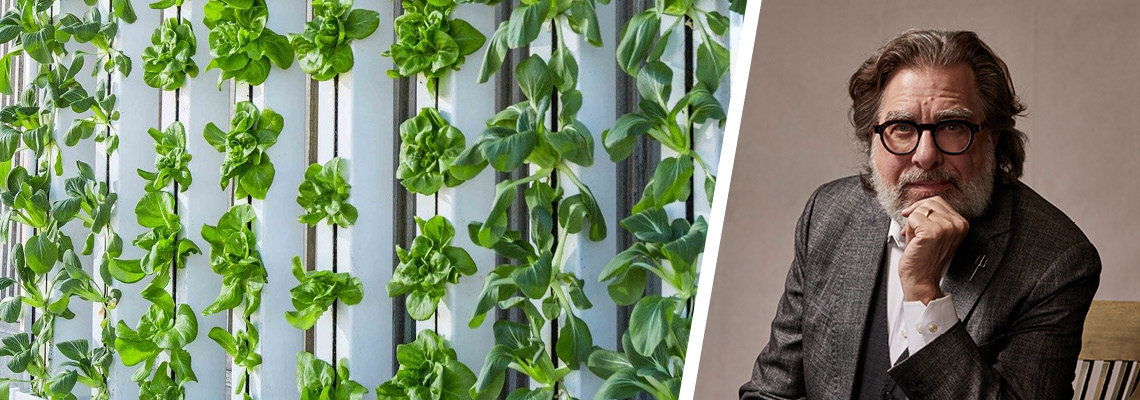Will Sarni: Vertical farming joins the third green revolution menu
We are now witnessing the emergence of one of the most significant trends of this century: vertical farming, writes Will Sarni.
We need an agricultural revolution
The world population is expected to reach nearly 11 billion by 2050. Representing an increase in agricultural demand of approximately 70 per cent, we will need a revolution in agriculture if we are to feed these additional 3.5 billion people.
The pandemic has also accelerated the need for this revolution. It has raised attention to the urgent need for improved natural resources management and more sustainable and resilient food supply chains. This can only be possible by moving agriculture to more populated, urban centres.
Advances in high yield seeds, fertilizers and pesticides drove the first green revolution. The second and third green revolutions are fueled by advances in digital technologies (World Economic Forum's 4th Industrial Revolution) and an urgent need to build more sustainable and resilient food systems.
Limits to the First Green Revolution
The first green revolution was a series of rapid technological and agronomic advances that occurred after World War II. This transformed agriculture. Saving over a billion people from starvation, it set the stage for the world’s population to increase from three billion in the late 1960s to an estimated 7.3 billion today.
American agronomist, Norman Borlaug led the first green revolution. He led the development of high-yielding varieties of cereal grains and the distribution of hybridized seeds, synthetic fertilizers, and pesticides to farmers.
Borlaug's contributions and the widespread adoption of irrigation infrastructure and modern agricultural management techniques greatly increased yields without requiring an expansion in agricultural land.
“The first green revolution was also accompanied by detrimental environmental impacts that continue to this day.”
However, the first green revolution was also accompanied by detrimental environmental impacts that continue to this day. Increased water use for irrigation, soil degradation, and chemical runoff are just some of the unintended consequences. These environmental costs have been a key factor in giving rise to the second green revolution, and now the third.
The Second Green Revolution and Digital Transformation
Over the past several years, we have seen the rise of smart precision agriculture. Digital technologies are enabling water resources and nutrients to be monitored more efficiently and effectively. Furthermore, weather and crop productivity can be monitored more closely.
“There is even greater potential when digital technologies are combined with satellite data applications;
The digital transformation of agriculture has also included advances in Artificial Intelligence (AI) and machine learning to better manage agricultural equipment while increasing productivity. The importance of digital technologies in vastly improving how we grow and distribute food cannot be overstated.
Examples of digital technologies advancing the second green revolution include Arable Labs delivering "decision agriculture" solutions, CropX with "data-driven farming" and Tal-Ya, “delivering new earth-friendly AgriTech solution”.
Closer to the ground, companies such as DroneDeploy’s mobile phone software simplifies multiple aspects of drone usage for mapping land and monitoring applications
There is even greater potential when these types of technologies are combined with satellite data applications from the NASA GRACE mission, which uses two spacecraft to map variations in the Earth’s gravity field.
Maps developed using the GRACE data are able to identify the difference between climate-related drought conditions and the depletion of aquifers through groundwater extraction that exceeds recharge.
The Third Green Revolution: Urban Indoor Agriculture
While digital technologies continue to be scaled, we are now witnessing the emergence of one of the most significant trends of this century: vertical farming. Urban indoor agriculture includes several types of “farms” – hydroponics, aquaponics and aeroponics.
There are numerous advantages to urban indoor agriculture, including:
- Vastly reduced environmental impact
- Improved food security and nutrition
- Poverty alleviation
- Improved land use.
Other advantages include:
- Ensures production of greens all year round in non-tropical climates
- Elimination herbicides and pesticides
- Crops are shielded from extreme weather events such as droughts, hail and floods
- Water conservation using about 70 per cent less water
- Elimination of heavy agriculture equipment with associated elimination of emissions.
One example of a successful urban indoor farm company is 80 Acres Farms, which capitalizes on digital technology advances from the second green revolution to “convert urban spaces into ultra-efficient farms that maximize energy and space”.
Its mission is to provide “accessible, nutritious, tasty, and affordable local food to everyone, using fewer resources” in the process. Robotics, artificial intelligence, data analytics, and around-the-clock monitoring sensors and control systems are combined to create food that is local and fresh 365 days a year.
The future of agriculture is more promising than ever with advances in technologies that solve “wicked” environmental and social problems.
Urban Indoor agriculture is now on the menu to deliver sustainable, resilient, healthy, accessible and affordable food, finally.

Will Sarni
CEO
Water Foundry
Related content
- Will Sarni on why we need a Skunk Works in water
- Will Sarni focus on water handprint, not footprint
- Zero mass water why all the hate
- Explore all our coverage related to urban water
Share your water technology stories with us
Do you have an innovation, research results or an other interesting topic you would like to share with the international water technology industry? The Aquatech website and social media channels are a great platform to showcase your stories!
Please contact our Sr Brand Marketing Manager Annelie Koomen.
Are you an Aquatech exhibitor?
Make sure you add your latest press releases to your Company Profile in the Exhibitor Portal for free exposure.
We promise never to send you spam and you can unsubscribe at any time!
